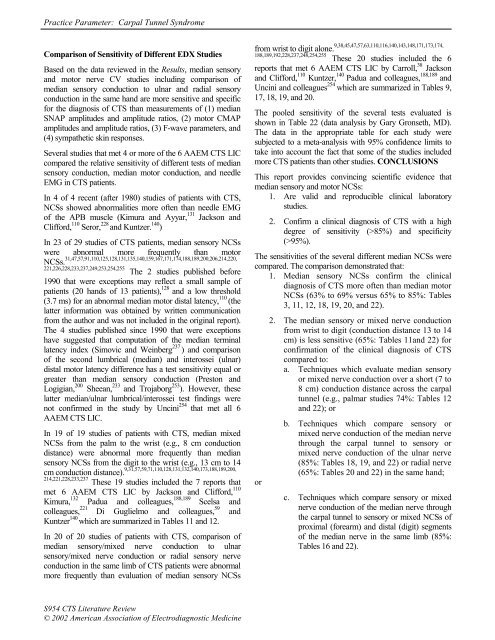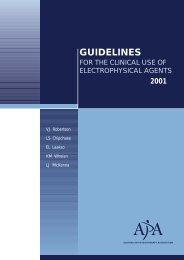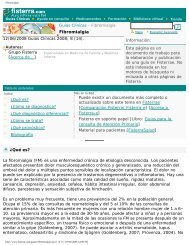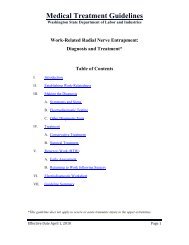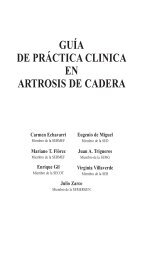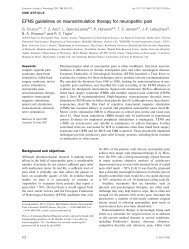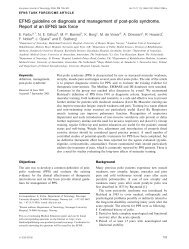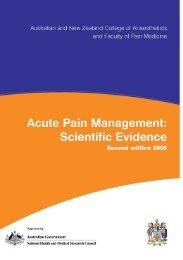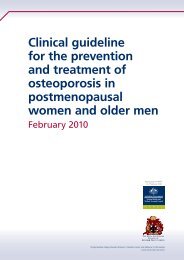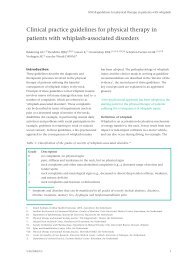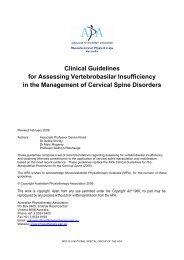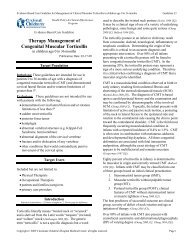Practice Parameter and Literature Review of the Usefulness of ...
Practice Parameter and Literature Review of the Usefulness of ...
Practice Parameter and Literature Review of the Usefulness of ...
Create successful ePaper yourself
Turn your PDF publications into a flip-book with our unique Google optimized e-Paper software.
<strong>Practice</strong> <strong>Parameter</strong>: Carpal Tunnel SyndromeComparison <strong>of</strong> Sensitivity <strong>of</strong> Different EDX StudiesBased on <strong>the</strong> data reviewed in <strong>the</strong> Results, median sensory<strong>and</strong> motor nerve CV studies including comparison <strong>of</strong>median sensory conduction to ulnar <strong>and</strong> radial sensoryconduction in <strong>the</strong> same h<strong>and</strong> are more sensitive <strong>and</strong> specificfor <strong>the</strong> diagnosis <strong>of</strong> CTS than measurements <strong>of</strong> (1) medianSNAP amplitudes <strong>and</strong> amplitude ratios, (2) motor CMAPamplitudes <strong>and</strong> amplitude ratios, (3) F-wave parameters, <strong>and</strong>(4) sympa<strong>the</strong>tic skin responses.Several studies that met 4 or more <strong>of</strong> <strong>the</strong> 6 AAEM CTS LICcompared <strong>the</strong> relative sensitivity <strong>of</strong> different tests <strong>of</strong> mediansensory conduction, median motor conduction, <strong>and</strong> needleEMG in CTS patients.In 4 <strong>of</strong> 4 recent (after 1980) studies <strong>of</strong> patients with CTS,NCSs showed abnormalities more <strong>of</strong>ten than needle EMG<strong>of</strong> <strong>the</strong> APB muscle (Kimura <strong>and</strong> Ayyar, 131 Jackson <strong>and</strong>Clifford, 110 Seror, 228 <strong>and</strong> Kuntzer. 140 )In 23 <strong>of</strong> 29 studies <strong>of</strong> CTS patients, median sensory NCSswere abnormal more frequently than motorNCSs. 31,47,57,91,110,125,128,131,135,140,159,167,171,174,188,189,200,206,214,220,221,226,228,233,237,249,253,254,255 The 2 studies published before1990 that were exceptions may reflect a small sample <strong>of</strong>patients (20 h<strong>and</strong>s <strong>of</strong> 13 patients), 128 <strong>and</strong> a low threshold(3.7 ms) for an abnormal median motor distal latency, 110 (<strong>the</strong>latter information was obtained by written communicationfrom <strong>the</strong> author <strong>and</strong> was not included in <strong>the</strong> original report).The 4 studies published since 1990 that were exceptionshave suggested that computation <strong>of</strong> <strong>the</strong> median terminallatency index (Simovic <strong>and</strong> Weinberg 237 ) <strong>and</strong> comparison<strong>of</strong> <strong>the</strong> second lumbrical (median) <strong>and</strong> interossei (ulnar)distal motor latency difference has a test sensitivity equal orgreater than median sensory conduction (Preston <strong>and</strong>Logigian, 200 Sheean, 233 <strong>and</strong> Trojaborg 253 ). However, <strong>the</strong>selatter median/ulnar lumbrical/interossei test findings werenot confirmed in <strong>the</strong> study by Uncini 254 that met all 6AAEM CTS LIC.In 19 <strong>of</strong> 19 studies <strong>of</strong> patients with CTS, median mixedNCSs from <strong>the</strong> palm to <strong>the</strong> wrist (e.g., 8 cm conductiondistance) were abnormal more frequently than mediansensory NCSs from <strong>the</strong> digit to <strong>the</strong> wrist (e.g., 13 cm to 14cm conduction distance). 9,31,57,59,71,110,128,131,132,140,173,188,189,200,214,221,228,233,237 These 19 studies included <strong>the</strong> 7 reports thatmet 6 AAEM CTS LIC by Jackson <strong>and</strong> Clifford, 110Kimura, 132 Padua <strong>and</strong> colleagues, 188,189 Scelsa <strong>and</strong>colleagues, 221 Di Guglielmo <strong>and</strong> colleagues, 59 <strong>and</strong>Kuntzer 140 which are summarized in Tables 11 <strong>and</strong> 12.In 20 <strong>of</strong> 20 studies <strong>of</strong> patients with CTS, comparison <strong>of</strong>median sensory/mixed nerve conduction to ulnarsensory/mixed nerve conduction or radial sensory nerveconduction in <strong>the</strong> same limb <strong>of</strong> CTS patients were abnormalmore frequently than evaluation <strong>of</strong> median sensory NCSsfrom wrist to digit alone. 9,38,45,47,57,63,110,116,140,143,148,171,173,174,188,189,192,228,237,248,254,255 These 20 studies included <strong>the</strong> 6reports that met 6 AAEM CTS LIC by Carroll, 38 Jackson<strong>and</strong> Clifford, 110 Kuntzer, 140 Padua <strong>and</strong> colleagues, 188,189 <strong>and</strong>Uncini <strong>and</strong> colleagues 254 which are summarized in Tables 9,17, 18, 19, <strong>and</strong> 20.The pooled sensitivity <strong>of</strong> <strong>the</strong> several tests evaluated isshown in Table 22 (data analysis by Gary Gronseth, MD).The data in <strong>the</strong> appropriate table for each study weresubjected to a meta-analysis with 95% confidence limits totake into account <strong>the</strong> fact that some <strong>of</strong> <strong>the</strong> studies includedmore CTS patients than o<strong>the</strong>r studies. CONCLUSIONSThis report provides convincing scientific evidence thatmedian sensory <strong>and</strong> motor NCSs:1. Are valid <strong>and</strong> reproducible clinical laboratorystudies.2. Confirm a clinical diagnosis <strong>of</strong> CTS with a highdegree <strong>of</strong> sensitivity (>85%) <strong>and</strong> specificity(>95%).The sensitivities <strong>of</strong> <strong>the</strong> several different median NCSs werecompared. The comparison demonstrated that:1. Median sensory NCSs confirm <strong>the</strong> clinicaldiagnosis <strong>of</strong> CTS more <strong>of</strong>ten than median motorNCSs (63% to 69% versus 65% to 85%: Tables3, 11, 12, 18, 19, 20, <strong>and</strong> 22).or2. The median sensory or mixed nerve conductionfrom wrist to digit (conduction distance 13 to 14cm) is less sensitive (65%: Tables 11<strong>and</strong> 22) forconfirmation <strong>of</strong> <strong>the</strong> clinical diagnosis <strong>of</strong> CTScompared to:a. Techniques which evaluate median sensoryor mixed nerve conduction over a short (7 to8 cm) conduction distance across <strong>the</strong> carpaltunnel (e.g., palmar studies 74%: Tables 12<strong>and</strong> 22); orb. Techniques which compare sensory ormixed nerve conduction <strong>of</strong> <strong>the</strong> median nervethrough <strong>the</strong> carpal tunnel to sensory ormixed nerve conduction <strong>of</strong> <strong>the</strong> ulnar nerve(85%: Tables 18, 19, <strong>and</strong> 22) or radial nerve(65%: Tables 20 <strong>and</strong> 22) in <strong>the</strong> same h<strong>and</strong>;c. Techniques which compare sensory or mixednerve conduction <strong>of</strong> <strong>the</strong> median nerve through<strong>the</strong> carpal tunnel to sensory or mixed NCSs <strong>of</strong>proximal (forearm) <strong>and</strong> distal (digit) segments<strong>of</strong> <strong>the</strong> median nerve in <strong>the</strong> same limb (85%:Tables 16 <strong>and</strong> 22).S954 CTS <strong>Literature</strong> <strong>Review</strong>© 2002 American Association <strong>of</strong> Electrodiagnostic Medicine


